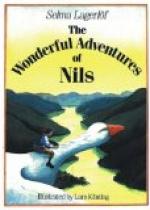All of a sudden he had looked up. “Now we are pretty stupid,” said he. “All this, of course, lies in our Lord’s Smaland, in that part of the land which was already finished when Saint Peter undertook the job. It’s only natural that it should be pretty and fine there. But in Saint Peter’s Smaland it looks as it says in the legend. And it wasn’t surprising that our Lord was distressed when he saw it,” continued little Mats, as he took up the thread of his story again. “Saint Peter didn’t lose his courage, at all events, but tried to comfort our Lord. ‘Don’t be so grieved over this!’ said he. ’Only wait until I have created people who can till the swamps and break up fields from the stone hills.’
“That was the end of our Lord’s patience—and he said: ’No! you can go down to Skane and make the Skaninge, but the Smalander I will create myself.’ And so our Lord created the Smalander, and made him quick-witted and contented and happy and thrifty and enterprising and capable, that he might be able to get his livelihood in his poor country.”
Then little Mats was silent; and if Nils Holgersson had also kept still, all would have gone well; but he couldn’t possibly refrain from asking how Saint Peter had succeeded in creating the Skaninge.
“Well, what do you think yourself?” said little Mats, and looked so scornful that Nils Holgersson threw himself upon him, to thrash him. But Mats was only a little tot, and Osa, the goose-girl, who was a year older than he, ran forward instantly to help him. Good-natured though she was, she sprang like a lion as soon as anyone touched her brother. And Nils Holgersson did not care to fight a girl, but turned his back, and didn’t look at those Smaland children for the rest of the day.
THE CROWS
THE EARTHEN CROCK
In the southwest corner of Smaland lies a township called Sonnerbo. It is a rather smooth and even country. And one who sees it in winter, when it is covered with snow, cannot imagine that there is anything under the snow but garden-plots, rye-fields and clover-meadows as is generally the case in flat countries. But, in the beginning of April when the snow finally melts away in Sonnerbo, it is apparent that that which lies hidden under it is only dry, sandy heaths, bare rocks, and big, marshy swamps. There are fields here and there, to be sure, but they are so small that they are scarcely worth mentioning; and one also finds a few little red or gray farmhouses hidden away in some beech-coppice—almost as if they were afraid to show themselves.
Where Sonnerbo township touches the boundaries of Halland, there is a sandy heath which is so far-reaching that he who stands upon one edge of it cannot look across to the other. Nothing except heather grows on the heath, and it wouldn’t be easy either to coax other growths to thrive there. To start with one would have to uproot the heather; for it is thus with heather: although it has only a little shrunken root, small shrunken branches, and dry, shrunken leaves it fancies that it’s a tree. Therefore it acts just like real trees—spreads itself out in forest fashion over wide areas; holds together faithfully, and causes all foreign growths that wish to crowd in upon its territory to die out.




